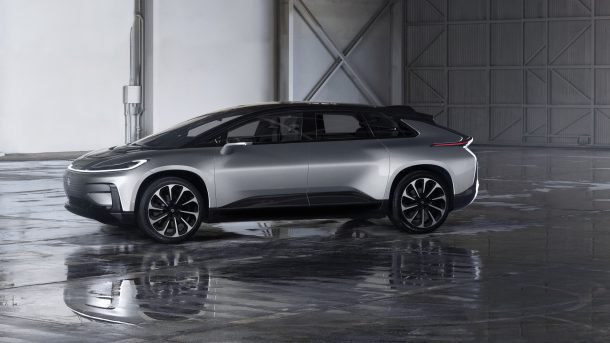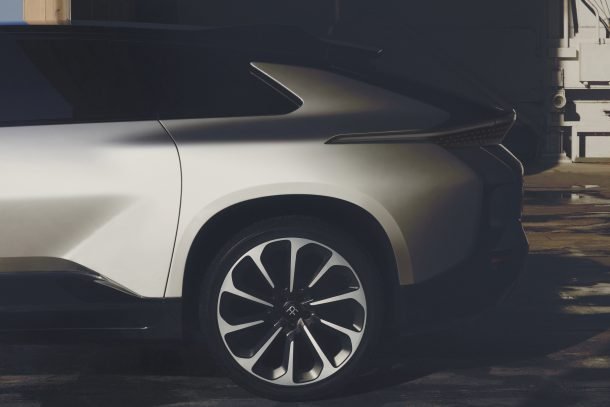Faraday Future's FF 91: A Closer Look at the Biggest Question Mark in the Industry

One year after Faraday Future (FF) revealed its futuristic and racy FFZERO1 concept, the company has pulled back the curtain on its first production car.
The FF 91 is cut from cloth similar to the recently revealed Lucid Air. Both cars are being built by California-based, Chinese-backed companies. And both are scheduled to follow Tesla into the EV Super Sedan market as Trump’s first term hits its midpoint.
The FF 91 will be built on FF’s proprietary Variable Platform Architecture (VPA). The VPA, with its integrated multi-motor powertrain, will enable FF to design vehicles of any style, size, or purpose. And by the numbers, the first car to use VPA will be a giant killer. According to Peter Savagian, VP of Propulsion Engineering, the car will offer the largest, most energy dense battery pack in the industry. The FF 91 will store 130 kilowatt-hours of energy and make up to 1,050 horsepower. It will best the Model S P100D, Tesla’s current range-topping sedan, meaning the FF 91 edges its better known rival in a 0-60 sprint by one-tenth of an unverified second.
In exchange for blistering straight-line performance, the FF 91 does not sacrifice range. FF claims 378 miles of EPA adjusted range, slightly ahead of the current Models S’ verified range and behind Lucid’s optional maximum range claim. The FF 91 features an open charging system that will accept any residential standard, including 110 and 240 volt AC at 1.5, 10, or 15 kilowatt levels. Not only that, but its class leading 200 kilowatt fast charging capability, as well as the prospect of wireless charging, will make the FF 91 easy to live with.
The car is dimensionally similar to a long-wheelbase Mercedes S-Class, though the proportions could not be more different. The FF 91 pushes the greenhouse so far over the front wheels that its abbreviated hood flirts with rakish minivan territory and the roofline extends well over the top of the rear passengers.
The closest analog to the FF 91’s profile may be the defunct Mercedes R-Class. However, the FF 91’s rear glass has a far more gradual slope and terminates at the sharp rear arc of the UFO line — FF’s term for the character line circling the car. Whereas the Lucid Air hues closer to the prevailing industry design trend of providing hatchback-like rear functionality combined with a stealthy roofline that suggests a sedan, the FF 91 embraces its hybrid wagon/hatch form with a pronounced flying buttress D-pillar.
Just how close to production is the design? FF representatives were reluctant to quantify, much less qualify an answer, but several details suggest some design elements may not make it to production.
For example, the B pillars look too broad. These blind-spot-inducing obstructions may be required to support the frameless glass in the doors and access buttons, but they lack elegance. And consistent with other manufacturers in the segment, passenger access is a focal point. FF has chosen to incorporate what we commonly call suicide doors, but the company prefers to refer to as an “entry system”. They point to the autonomous parking/retrieval capability as a practicality enabler, but suicide doors they remain and regulators may have something to say about them. Additional technical risks remain under the skin, where engineers are experiencing challenges getting all 45 computers to talk to each other.
Making the most connected car ever will not be easy.
The product reveal was again scheduled to coincide with the massive Consumer Electronics Show in Las Vegas and was well attended by the press. Approximately 500 media, VIPs, and employees gathered inside an expansive enclosure near the north end of Las Vegas Boulevard.
On stage, FF not only revealed its new car, but ran 0-60 mile times with their benchmark competitors. A Bentley, Ferrari, two Teslas, and finally the FF 91. But in spite of the showmanship and FF’s intricately executed PR teaser campaign, the spotlight was as much on the company as it was on the car. Recent departures of senior executives combined with rumored financial disagreements with vendors put a shadow over the event too big for MC Nick Sampson, EVP of Engineering, to ignore. And in closing he acknowledged as much when he said, “Despite all the nay sayers, the skeptics. We will persist. We will carry on to make the impossible possible.”
Whether FF brings the FF 91, or any car, to market remains to be seen. But they demonstrated live last night their willingness to take risks and keep pushing forward. At the very least, we now know Faraday Future has a real car.
[Images: Faraday Future]

Twenty year auto industry professional. Currently CEO at Turbo International, the premier American manufacturer of OEM replacement turbochargers for the global aftermarket.
More by Seth Parks
Latest Car Reviews
Read moreLatest Product Reviews
Read moreRecent Comments
- SCE to AUX Range only matters if you need more of it - just like towing capacity in trucks.I have a short-range EV and still manage to put 1000 miles/month on it, because the car is perfectly suited to my use case.There is no such thing as one-size-fits all with vehicles.
- Doug brockman There will be many many people living in apartments without dedicated charging facilities in future who will need personal vehicles to get to work and school and for whom mass transit will be an annoying inconvenience
- Jeff Self driving cars are not ready for prime time.
- Lichtronamo Watch as the non-us based automakers shift more production to Mexico in the future.
- 28-Cars-Later " Electrek recently dug around in Tesla’s online parts catalog and found that the windshield costs a whopping $1,900 to replace.To be fair, that’s around what a Mercedes S-Class or Rivian windshield costs, but the Tesla’s glass is unique because of its shape. It’s also worth noting that most insurance plans have glass replacement options that can make the repair a low- or zero-cost issue. "Now I understand why my insurance is so high despite no claims for years and about 7,500 annual miles between three cars.






































Comments
Join the conversation
How likely is it that this behemoth will glide uninterruptedly through dense traffic in self-driving mode? Toyota might 'retaliate' by making its tiny, nimble i-Road self-driving and have it pass the FF from all sides.
It looks.....French NTTAWWT